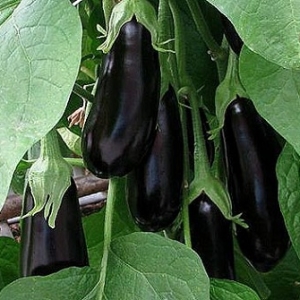Eggplant grows well and fruits mainly in warm and wet conditions. The climatic requirements of the thermo-loving plant correspond to only the south side of Russia. In the remaining regions, eggplant is recommended to be grown exclusively in greenhouses or greenhouses.
How to care for eggplants - seedlings and landing
The key to a good harvest is a strong, hardened and healthy 50 day seedlings. The plant is considered ready for a transplant to the ground when the first leaves appeared on the stem 6-7.
- Seedlings are peeing into carefully prepared and disinfailed soil. It is pre-dripped by 1 bayonet shovel, align and spill a light-pink solution of manganese. 4-5 days before landing, half a bucket of compost, a quarter of a glass of any complex mineral fertilizer and 2 glasses of wood ash contribute to 1 sq. M.
- The transplant is carried out at a temperature not lower than 18 degrees. The well spill a warm water in advance, after which the plant is planted along with a lump of land. The stem is not very deepened, leaving above the surface of the Earth by 2-3 cm.
- Culture loves space and light to meet its requirements, disembark no more than 3 - 4 bushes per 1 sq.m.

How to care for eggplants - ventilation and watering
After dive, the first watering is carried out after 4-5 days. During this time, seedlings "pass" and will be ready for full care.
Watering plants are carried out exclusively with warm and stretched water. For the week, eggplant watered at least 2-3 times, preferably in the morning. If the temperature regime exceeds 30-35 degrees, eggplant is watered daily. Each bush is spent from 1 to 2 liters of water, avoiding entering the leaves.
The culture does not tolerate the stool and loves fresh air, but without drafts. Open the windows of the greenhouse for ventilation, it is necessary even in cloudy weather, and especially after watering so that the roots of the plant are not injured from high humidity. With warm and sunny weather, the greenhouse is held open in the morning and closed after sunset.

How to care for eggplants - feeding and garter
Culture speaks well to regular organic feeding. In additional nutrition, the plants must take such trace elements as boring, copper and molybdenum.
- After 14 days after the dive, the first root feeder is carried out - 20 g of calcium nitrates are divorced in 10 liters of warm water.
- During the ripening period of buds, the root system is poured by dung alive, diluted with water 1 to 10.
- Until the end of the season, every 10 days the soil is fed by various complex and mineral fertilizers.
- Also 2 times over the summer it is necessary to produce out the root feeder - the leaves and the oscillates are sprayed with a cyimeroxum (10 g / 10 liters of water).
The soil is loosened as earth lumps are the formation, but not less than 1 time in 7 days. Also, plants need a robust backup. So that the fruits are not rotten, and the leaves are not a graticle ahead of time, the stem is tied up to a wooden peg, a grinder or wire.

How to care for eggplants - the formation of a bush
The culture itself does not need a special formation. But for active growth and increase in the crop, it is necessary to regularly remove steps in sinuses, spoiled leaves and side empty shoots.
- When forming 9-10 leaves, together with the first urging, the first stepper appears. So that it does not convert into the second stem, it and the bud must be removed.
- When 5-6 strong strings appear on the bush, the height point of the main stem must be seen.
When the plant is firmly formed and actively blooms, all inflorescences need to be removed, leaving 2-3 for full-fledged development. If this is not done, the bush will score inflorescences, and without forming the fruit.

How to care for eggplants - harvest
With good care, the first harvest fee is carried out 35-40 days after the transplantation of the plant. Searches for "newbies" spend once every 5 days. The color in the ripe fruit should be bright, with shiny peel. When peaped eggplant acquires a brown color and loses its taste. The harvest gardeners are stored no more than 30 days, in dry boxes, straw or paper.































